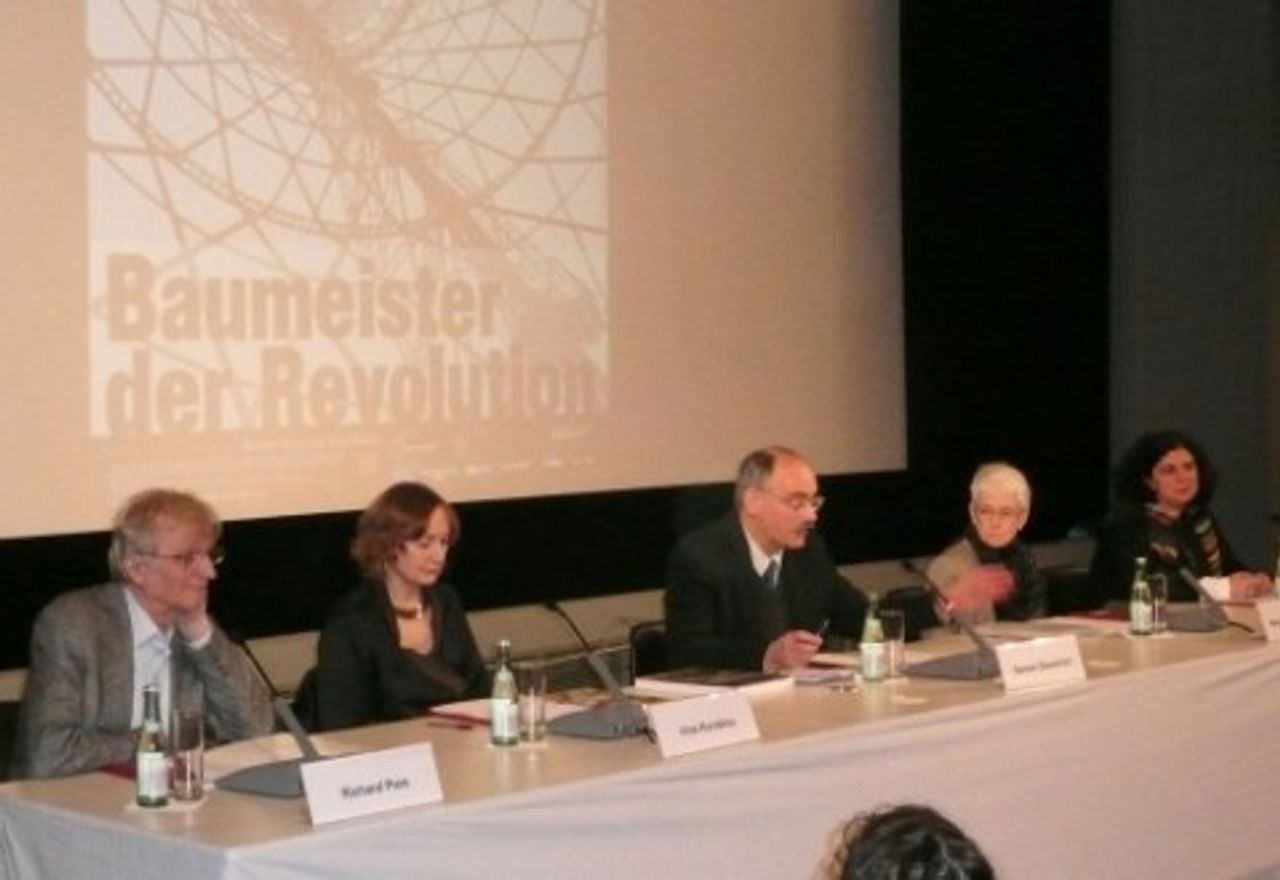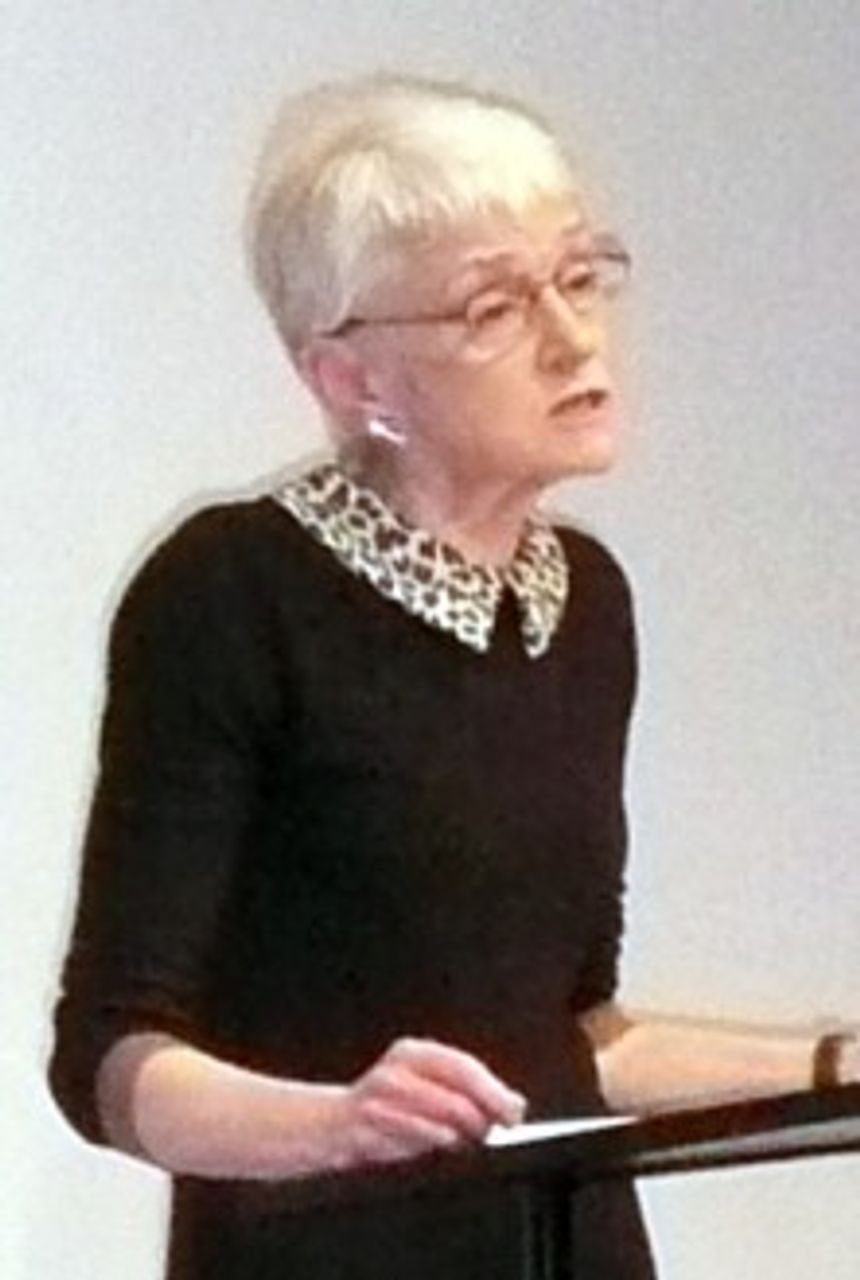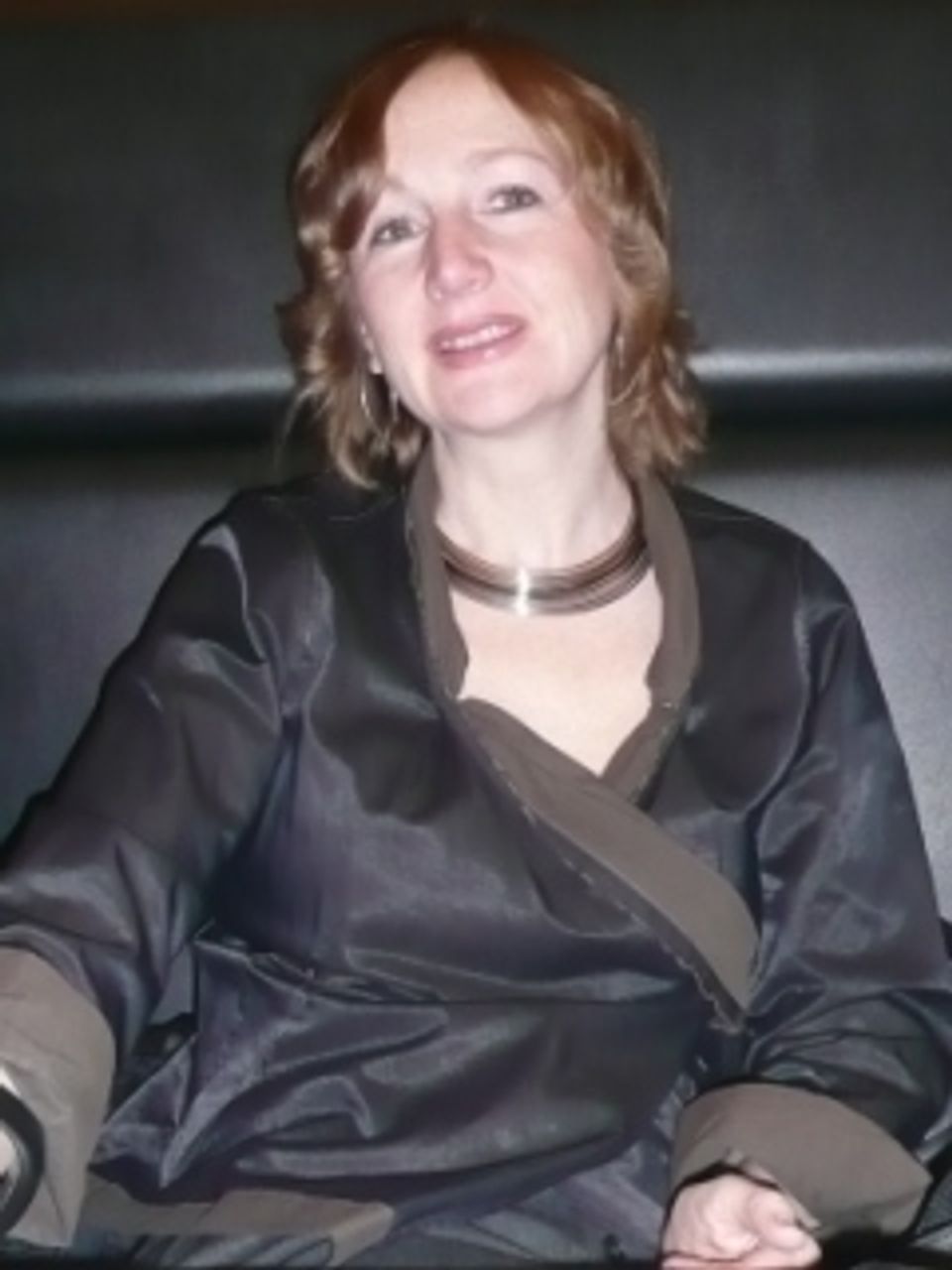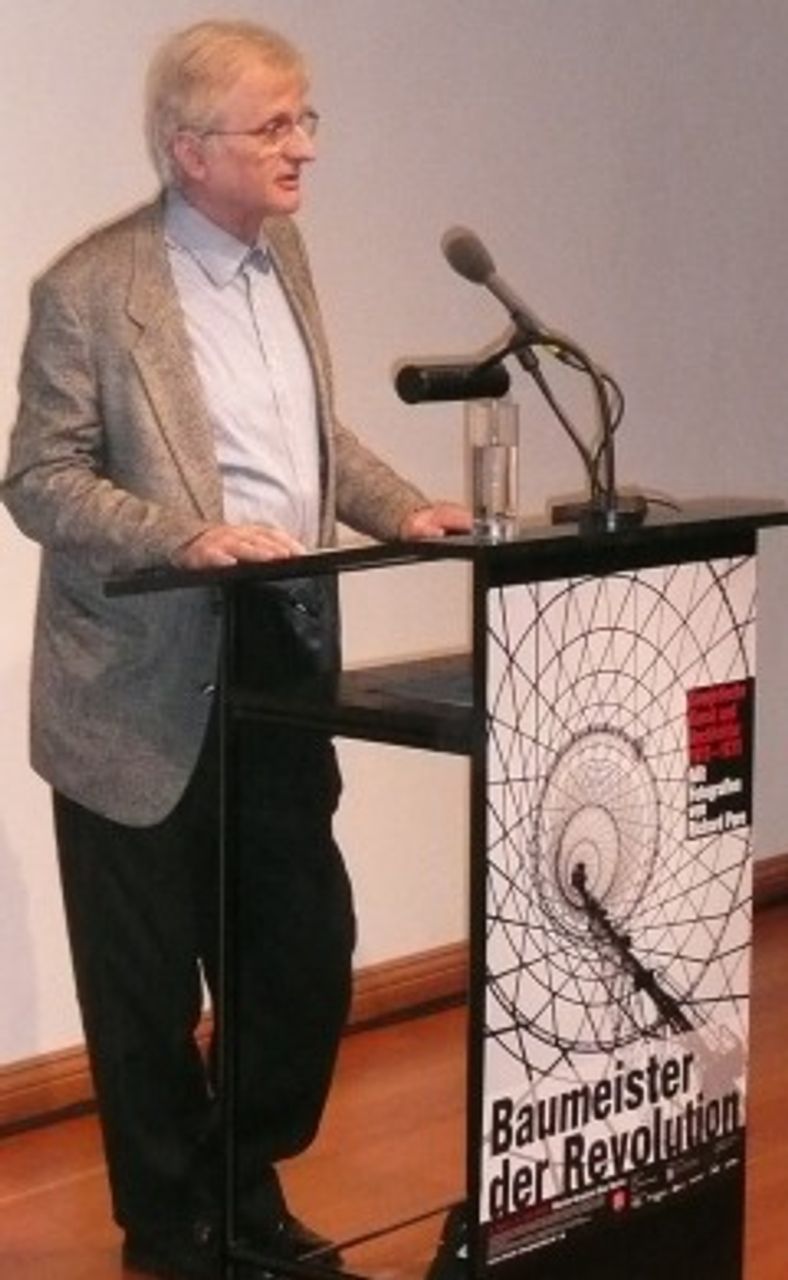“The creation of a new society! The chance to participate as an artist in the momentous enterprise by constructing buildings, establishing a new way of life, forging new and better living conditions for the people—that was what inspired the architects of Constructivism in the early years of the Soviet Union!”
These were the words that opened the exhibition “Building the Revolution: Soviet Art and Architecture from 1915 to 1935” at the Martin-Gropius-Bau in Berlin on April 5. And this was the theme emphasised by almost all the speakers at the well-attended and lively press conference in the morning and the opening ceremony in the evening.
 Press conference at the exhibition opening: From left to right: Richard Pare, architectural photographer; Irina Korobina, director of the Shchusev State Museum of Architecture, Moscow; Gereon Sievernich, director of the Martin-Gropius-Bau, Berlin; Mary Anne Stevens, director of the Royal Academy of Arts, London; Maria Tsantangolou, director at the State Museum of Contemporary Art, Thessaloniki, Greece.
Press conference at the exhibition opening: From left to right: Richard Pare, architectural photographer; Irina Korobina, director of the Shchusev State Museum of Architecture, Moscow; Gereon Sievernich, director of the Martin-Gropius-Bau, Berlin; Mary Anne Stevens, director of the Royal Academy of Arts, London; Maria Tsantangolou, director at the State Museum of Contemporary Art, Thessaloniki, Greece.In his welcoming comments, Gereon Sievernich, director of the Martin-Gropius-Bau, underscored the fact that Soviet architecture’s pursuit of its important goals following the 1917 October Revolution was accompanied by an intense and fruitful exchange of ideas and concepts among architects and artists all over the world.
“The current exhibition is dedicated to this unique artistic period and exploits the outstanding photography of Richard Pare to document dramatically the extent to which the survival of their work is today threatened by dilapidation, misappropriation and wanton neglect”, said Sievernich, and continued: “The message is clear: These artworks are not only the heritage of Russian culture; they are an integral part of world cultural heritage. It is high time that they are recognised as such!”
Sievernich emphasised that the exhibition itself was the result of a genuinely international effort. Paintings from the Russian and Soviet avant-garde were made available from the Kostakis collection of the Thessaloniki State Museum of Contemporary Art. Highly informative archive material was provided by the Shchusev State Museum of Architecture in Moscow (MUAR). Richard Pare, the British-Canadian architectural photographer, made his photographs available and contributed to the original conception of the exhibition. The Royal Academy of Arts (RAA) in London participated as its leading sponsor and, finally, the Martin-Gropius-Bau in Berlin served as host.
 Mary Anne Stevens
Mary Anne StevensMary Ann Stevens, the RAA’s director, said: “The aim of building a better, socialist world inspired millions in those years, not only in Russia. These days you may say what you like about this aim, but back then it was an inexhaustible source of energy and ideas for artists who wanted to work for its fruition and succeeded in creating masterpieces of architectural culture for humanity”.
She explained how the architects dispensed not only with traditional design concepts: “They also attempted a radical break from the old tsarist and bourgeois society in the field of art. Painting and architecture were integrated; as the starting point and guiding principle for creativity in both fields of art were raised the ideal forms of geometry, not the given reality, which was to be overcome. Traditional ornamentation and all bombast that smelled of glorification of the existing conditions were discarded. Heralding the future, towering in the skies, the buildings were to be visionary—as the life within them”.
The exhibition not only strives to convey the goals and visions of that artistic period and its society, it also examines the threat posed to the Constructivists’ creations by today’s society and culture in Russia.
Irina Korobina, director of MUAR, thus made a passionate appeal to the audience: “Do your bit to preserve these works of humanity! These works belong to us all, they belong to humanity!”
Responding to a question from a press conference visitor, as to whether or not the billionaire oligarchs in Russia—who certainly possess unlimited funds—would not be able to finance the necessary restoration and reconstruction work, she made the following comment:
“The very idea of such a thing is completely absurd! I know of only one instance when an oligarch bought a house in the Constructivist style. But he was not interested in maintaining it as a piece of art. Oligarchs might want to set up a sauna in such a building, or maybe enjoy flaunting it. But they are not interested in maintaining works of art for their own sake; they simply don’t appreciate the arts at all.
 Irina Korobina
Irina Korobina“The capitalist society that has been restored in Russia since perestroika has different ideals from those of the Soviet society and art circles of the 1920s. Participating in the building of a new and more human society; the development of a new architecture in which the buildings, their design and structure, and every single room have to fulfil a social function—that was at the heart of avant-garde Constructivism! That is far away from today’s reality in Russia”.
Interviewed by the World Socialist Web Site, Korobina expanded on this idea in some detail. She pointed out that under Stalin’s rule and his artistic doctrine of “Socialist Realism”, from the early 1930s onward, not only were the aims and principles of architecture radically changed from above. In that period the Stalinist authorities were already beginning to allow the creative works of Constructivism and the Soviet avant-garde to fall to ruins.
Korobina explained that “transparency and designing buildings as domes of light constituted fundamental principles of Constructivist architecture”, and continued: “The starting point for the architecture of a building was the consideration of its overall function and the functions of its individual parts. Under Stalin, however, residential and administrative establishments were built to make an external impression by proclaiming the ‘victory of socialism’ with grandiose facades—but nothing was properly thought through for the inside of the buildings, nothing appropriate to the daily needs of life and work.”
She continued: “The Social Realist architects were—unlike the Constructivists—actually ‘formalists’. Prior to any consideration of the function of a building, its form had to be determined. It was often the case that how a building was to be used was only decided after its construction. Consequently, the rooms were too dark to live and work in, the hallways too narrow and winding, the buildings simply impractical.
“The dominant issue for the Constructivists, on the other hand, was to facilitate communication and interaction among the residents of their buildings, and promote opportunities for sport and physical activity. To this end, the typical workers’ club was designed with open spaces and an open construction with an upward striving form, and of course a variety of sports and leisure facilities.
“From the beginning of the Stalinist era, however, it was important for the bureaucracy to gather larger crowds in enclosed spaces, where they sat as passive audiences of film, theatre and propaganda events. The Constructivists’ buildings were no longer suitable for such use. Therefore, the frequent misuse of Constructionist edifices dates from this time, as does their dilapidation and decay through total neglect. All these processes were accelerated with the introduction of perestroika [in the late 1980s] and capitalism. The results of this upheaval have been captured for all to see in the photographs of Richard Pare!”
The latter photos are the visual and thematic focus of the exhibition. They are also the link between the archival photos, paintings, visionary drafts and drawings from the past, on the one hand, and present reality, on the other. The amazing thing about Pare’s photographs is that despite the depressing contemporary condition of their subjects, they are still able to convey to the viewer the optimism that filled and encouraged the artists of the 1920s.
Of crucial significance in this respect is the photographer’s artistic sensitivity to the special aesthetics of each of the buildings photographed, and his ability to communicate this through appropriate composition, well thought-out lighting and well-chosen angles.
 Richard Pare
Richard PareRichard Pare spoke with the WSWS that evening: “Yes, I felt the optimism of those artists while I was working and I wanted to express it! I wanted to pay tribute to the whole artistic attitude and world view that moved the architects of that time: they believed the task of an artist was to participate in the creation of a new society by contributing his or her own ideas, innovative concepts and bold visions.
“Of course, all of this is anathema to adherents of today’s prevailing cultural trends in Russia: the rich and super-rich there have no understanding of the arts and culture. They are not interested in such things. This is obvious alone from the fact that the Moscow Architecture Museum is drastically underfunded and has to fight for its survival”.
WSWS: “What is the answer to this problem? How can these works of art be preserved?”
Richard Pare: “Of course, the ideal solution would be for someone to buy them for philanthropic reasons, and then hand them over to universities or art institutes to operate and maintain. But the chance of that happening is far removed from the reality of today!”
WSWS: “It would seem that an enormous revolutionary upsurge and cultural transformation is necessary for the preservation of these works of art, just as it was in the past for their design and realisation.”
Richard Pare: “Yes, that’s true. But that’s something we should be working on right away. We must do all we can to show the value and significance of these works and alarm the world about their perilous condition. And, of course, it would be good if exhibitions like this one could move and inspire as many people as possible with the ideas and goals of these revolutionary artists”.
The chances of this happening are by no means slim. Numerous visitors flocked to the Martin-Gropius-Bau in the first days of the exhibition. It is also quite rare for an exhibition about architecture to run for as long as this one, namely three months, until July 9.
The creators of the exhibition themselves were obviously inspired by the principles of Constructivism as well. Five huge rooms with large spaces and high ceilings make it possible for plenty of light, transparency and clear functional structuring to facilitate the visitor’s examination of the numerous exhibits and their diverse artistic, social and historical aspects.
In each of the exhibition’s rooms, dedicated to a particular topic, one long wall displays the works of Russian avant-garde painters such as Lyubov Popova and Alexander Rodchenko, who influenced the architects or directly cooperated with them. Pare’s large-scale photographs on the opposite wall show the buildings in their current environment and architectural condition. And finally, glass cases in the middle of each room display accompanying historical photos, drafts, drawings and other archival objects from the 1920s, all of which have been made available by MUAR. These document the original concepts, drafts and former appearance of the buildings immediately after their completion.
As a visitor, one would have wished for more detailed texts with explanations about the lives and evolution of the various artists, as well as the various artistic tendencies, their social background, conceptions and influences on later developments in art. Yet all this has been put into the catalogue and a voluminous and well thought-out program of information that allows for a serious study of Constructivism, its predecessors in various forms of art and its social roots.
Audio guides are offered to visitors, especially children, and youth and students are invited to participate in numerous workshops introducing architectural photography, studio work with geometric shapes and the basic ideas of Constructivism. One workshop even encourages participants to develop ideas and concepts for a reconstruction of the city of Berlin along Constructivist lines.
Mehring Verlag’s exhibition German-language catalogue contains all the exhibits with explanatory texts and is also available as a high-quality hardback book. This will prove a valuable memento for all who attend the exhibition and enable them to later deepen the experience of their visit. It is an excellent alternative for all those unable to visit the exhibition.
